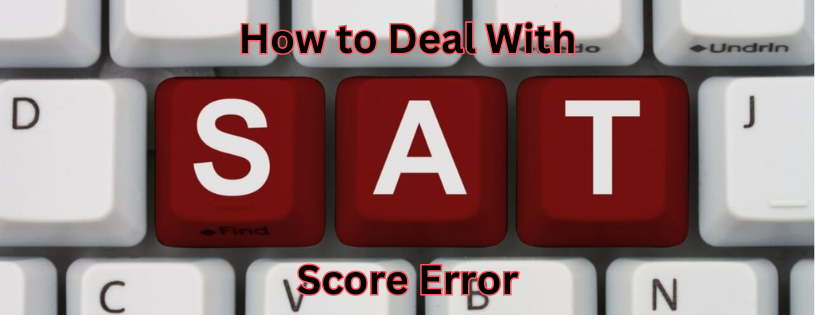How to Deal With SAT Score Errors?
The Scholastic Aptitude Test (SAT) examination is a standardized college admissions test in the US. The students planning to study in colleges and universities in the United States are required to appear for this examination. The test is taken to assess the student’s key skills such as reading comprehension, computational ability, and clarity of expression. This test is a highly effective measure to test intellectual potential. The test is mostly objective in nature with only one subjective section in the form of an essay section.
It is only the SAT score that decides your future in universities across the US. But there are chances of error in SAT scores. Mistake in SAT score is rare but nothing to worry about, there are a few methods to verify the SAT score, case there are no errors or worries, it gives you an opportunity to improve. The mistake could be made in two ways either by the College Board or by the applicants themselves.
It is very rare for the College Board to give incorrect scores but it does happen. But before beginning the process of score verification, you should be open to the fact that maybe there were no errors with the score. Also that the score obtained after the correction of scoring error may result in low scores which will not be changed again. Some of the reasons behind incorrect scores are:
Errors did by the College Board:
- Sending the incorrect score report to the test taker
- Wrongly printing a question or the sectional time of the test booklet
- Problematic scanning of answer sheets and essays
Errors did by the Applicants:
- Filling answers in the incorrect section
- Filling answers in the incorrect test identifying code
- Answering the essay question with a pen instead of a pencil
- Wrongly filled answer bubbles (for example – not filling the bubbles properly, not shading the bubble dark enough, etc)

Explore the SAT Course Book a Free Trial Session
Dealing with Suspected SAT Score Errors: A Comprehensive Guide
While the SAT scoring process is generally reliable, there's always a chance of encountering an error. If you suspect your score might be inaccurate, here's a detailed guide to help you navigate the process of resolving the issue:
Step 1: Verify Your Score
Before initiating any action, double-check your official score report on the College Board website. Ensure you're looking at the correct test date and score report version.
Step 3: Identify the Discrepancy
If you believe there's a mistake, pinpoint the specific section or question where the error might have occurred. Here's how to strengthen your case:
Gather Evidence: Collect any supporting documentation you might have, such as notes from the test day or practice problems you struggled with.
Recall Details: Try to remember the specific question or section where you felt confident about your answer but received a different outcome.
Review Answer Choices: If applicable, consider whether there might have been an issue with the answer choices themselves being unclear or ambiguous.
Step 3: Consider Score Verification Services
The College Board offers two verification services for a fee:
Student Answer Verification (SAV) ($15 per section): This allows you to review a photocopy of your answer booklet alongside the College Board's scoring of your responses. You can identify any discrepancies in how your answers were marked.
Hand Scoring Service (Variable Cost): This involves a manual rescore of your multiple-choice questions or essay (depending on your request). This service can be more expensive than the SAV, so it's important to weigh the potential score increase against the cost.
Step 4: Contact the College Board
If you're confident there's a scoring error, it's time to reach out to the College Board. Here's how:
Website: Submit a request through the College Board's official website using their contact form. Clearly explain the situation and provide any supporting documentation you have collected.
Phone: Call the College Board's customer service department at 866-756-7307 to discuss your concerns directly with a representative.
Important Considerations:
Time Limits: There are deadlines for requesting score verification services. Visit the College Board website for the latest information on timelines.
Cost-Effectiveness: Consider the potential score increase and weigh it against the cost before requesting a rescore. A small score change might not justify the expense.
Alternatives: Even if you don't suspect a scoring error, a low SAT score doesn't necessarily end your college dreams. Many colleges consider a holistic application process, including factors like GPA, extracurricular activities, and essays. Research your target schools to see if they offer test-optional policies or have alternative admissions options.
Additional Resources:
The College Board's website is an invaluable resource for all things related to SAT scores, score verification, and frequently asked questions (FAQs). They also provide detailed information on the verification process itself, including deadlines and costs:
Dealing with a potential scoring error can be stressful, but by following these steps and gathering the necessary evidence, you can effectively communicate your concerns to the College Board and advocate for a fair review of your score. Remember, even if you don't see a significant score change, the peace of mind knowing you explored all options can be valuable.
SAT eBook
It is very important to know minor to major facts when starting your preparation for an aptitude-based exam like SAT, with updates that can help with your SAT preparation.
We are pleased to announce the release of TestprepKart's free SAT study guide for the new SAT. This free SAT ebook gives you everything you need to know about the test, from content to content mastery, among the top practice goals you need.

Download SAT eBook
SAT Preparation Resources:



Post a Comment